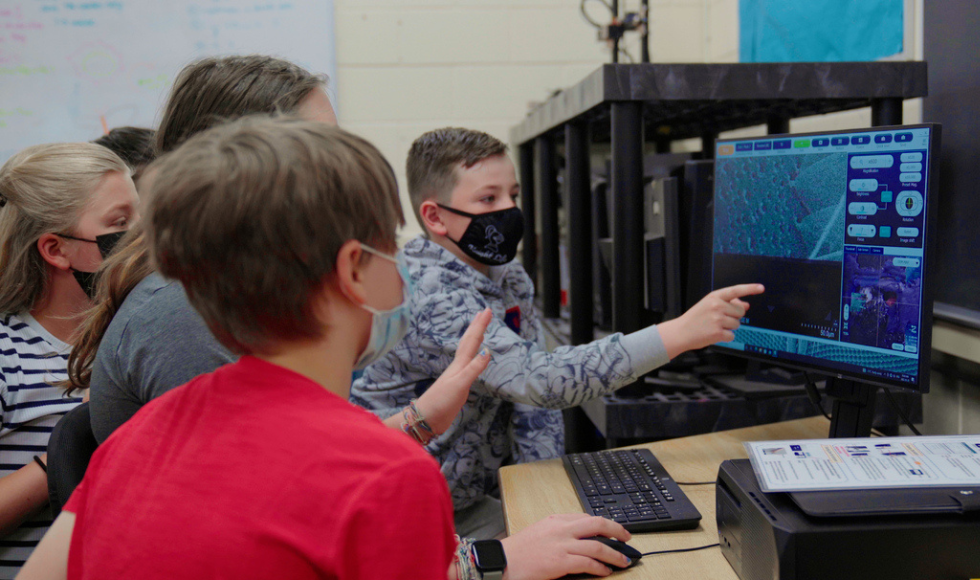Portable electron microscope brings a hidden world into view

Grade 5 students in Dundas got to use an extremely sophisticated scanning electron microscope that can display features on the scale of nanometres, or billionths of a metre. (Photo by Matt Clarke, McMaster University)
Like his Grade 5 classmates at Dundas Central Elementary School, Theo had never given much thought to moths.
Then a team from the Canadian Centre for Electron Microscopy (CCEM) set up a super-powerful microscope at their school and another world opened, including a whole new and fascinating take on the lowly insects.
In the first moments of the opening training session, the screen on the scanning electron microscope’s monitor filled wall-to-wall with moth, revealing amazing details, right down to close-up views of the tiny scales that coat its papery wings — scales that end up as “powder” on the fingertips of any person who has handled one.
Almost immediately, Theo and his classmates were comfortably zooming in and out and roving all over the prepared sample, later to be followed by others featuring a crane fly, rocks and other materials.
“I thought it was really cool,” Theo said. “When you think of a bug, you think of it as a little thing that has legs and can move, but once you see it through the electron microscope, you think, ‘This is awesome.’ It’s so different from everything else I’ve ever seen, in so many different ways.”
The Hitachi desktop scanning electron microscope the pupils were using is more typically used by scientists and has the capacity to display features on the scale of nanometres, or billionths of a metre.
Researchers come from across Canada and around the world to use the suite of permanently installed, super-high-resolution instruments at the CCEM, some of which are capable of looking at single atoms. The facility is located in a specially constructed, vibration-resistant building on the campus of McMaster University, where Nabil Bassim is scientific director.
The portable electron microscope has been on loan to the CCEM through Hitachi’s Inspire STEM Education Outreach Program, which aims to stimulate young people’s interest in science, technology, engineering and mathematics, or STEM.
“Revealing that there’s a hidden world that they can’t see with their eyes might get them inspired to pursue academic interest in this kind of work, and just to be generally educated citizens,” Bassim said.
“As a professor of microscopy, I see this every day and, to be honest, I never cease to be amazed at what kind of features one can see in different kinds of materials. We want to share that sense of wonder with them as well.”
The microscope’s recent four-week stop at Dundas Central — the third in a CCEM-organized tour that has also included schools in Scarborough and Brantford — fit perfectly with the plans of Grade 5 and 6 teacher Robert Bell.
His special project for the year — soon to be the subject of a special-edition book by his class — has been for students to examine their world from many perspectives.
Working in collaboration with the university’s community outreach and education program, McMaster Children & Youth University, Bell has welcomed experts in astronomy, philosophy and science to generate a complete picture of the world his young students inhabit.
“What we’re trying to create here is a little piece of campus here in our elementary school,” Bell said. “We’re trying to plant seeds, if you will, that will pay tremendous dividends in students’ lives.”
Grade 8 teacher Jacquelyn Swartz, who teaches science and other subjects, had used a similar microscope during her own science studies in university. She said she was thrilled to see Central pupils getting an early turn at using such a sophisticated instrument.
“Having the scanning electron microscope available at Dundas Central affords our students the most incredible opportunity to look at the world in an entirely new way,” she said. “I think it allows them to understand their place in the world and how they are related to all things.”
Samantha Stambula, who is responsible for outreach at the microscopy centre, organized the microscope’s visit with Hitachi’s Lori Harvey, Manager of STEM Outreach, Diversity, Equity and Inclusion and CSR Programs.
Stambula said she has enjoyed witnessing the wonderment of pupils as she trained them how to use the microscope.
“We want to be able to ignite an interest in science and engineering that would help bring them into the university in some of these programs and help to increase the diversity of students in those areas as time goes on,” she said.
For more information, or to apply to the NextGen Microscopist Program visit CCEM’s website or email Samantha Stambula at stambusm@mcmaster.ca.

